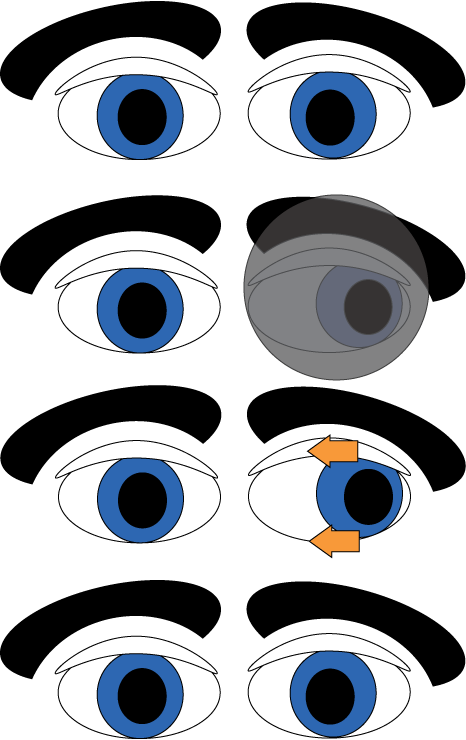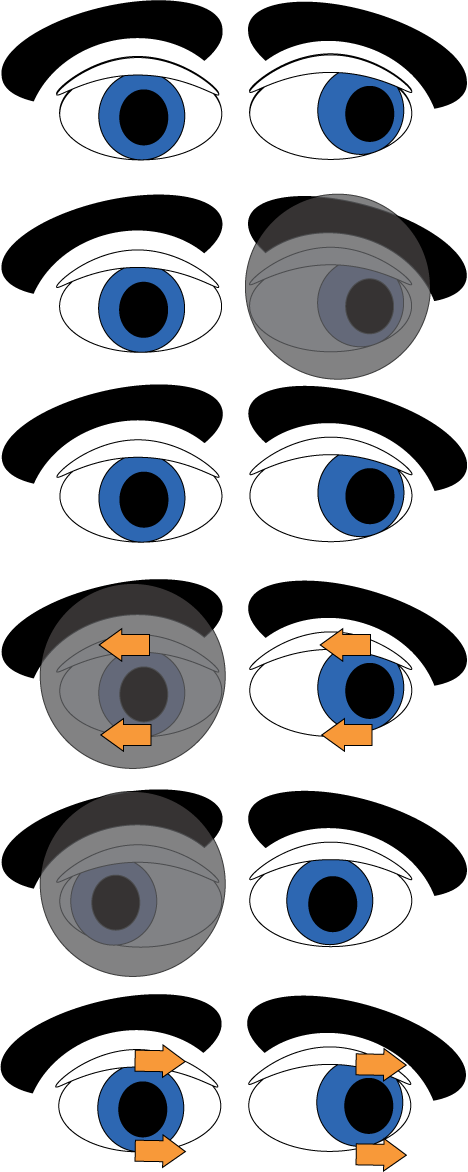Cover Test
A key component of a comprehensive eye examination is the assessment of eye teaming, or binocular vision. Eye teaming, or binocular vision, is a visual efficiency skill where both eyes work together in a precise and coordinated way. Good eye teaming allows sustained, single, and comfortable vision, and is the basis for depth perception.
The cover test is a measurement of eye posture (or eye alignment). The test is performed in two steps. First, the clinician covers an eye with a hand or paddle and looks for movement of the fellow eye. The cover paddle is then removed, and the clinician looks for movement of the previously covered eye. This step is called the cover-uncover test. When covering an eye and watching the non-covered eye, the clinician is looking for strabismus (also referred to as squint or tropia). When watching the previously covered eye, the clinician is looking for a phoria (the "natural" eye position of a patient when fusion is disrupted).
The second step of the test is called the alternating cover test. Here the clinician covers an eye and moves the paddle to the next eye. While moving the paddle back-and-forth, the clinician is looking for subtle movement of each eye. The alternative cover test described here is again looking for very small phoric misalignment. In each step of the test, the clinician may also use a prism lens to measure the amount of misalignment of either the strabismus (tropia) or phoria.
The cover test is commonly performed at distance (6m) and at near (40cm), though in some cases the cover test is performed in multiple positions of gaze (up-left, up, up-right, right, down-right, down, down-left, left, and central gaze).
The cover test is a critical component to understanding how a patient's eyes move and team. Abnormal eye positioning could be a cause for numerous symptoms, such as double vision (diplopia), eye strain (asthenopia), reading difficulties, headaches, and more.
Classification
The results of a cover test are reported in type, duration, direction of misalignment, magnitude, and comitancy.
Type of Misalignment
Ocular misalignment that is visible without dissociating the patient with a cover paddle or prisms is termed a heterotropia. If only manifest under dissociative conditions, the misalignment is termed a heterophoria.
Duration of Misalignment
-
Constant - the eye is deviated at all times and all distances.
- Intermittent - the eye does not deviate constantly but may deviate under certain conditions or stressors (such as reading or near work).
Direction of Misalignment
-
Ortho - the eye(s) shows no misalignment.
-
Exo - the eye(s) tends to turn outwards.
-
Eso - the eye(s) tends to turn inwards.
-
Hyper - the eye(s) tends to turn upwards relative to the fellow eye.
-
Hypo - the eye(s) tends to turn downwards relative to the fellow eye.
-
Incyclo - the eye(s) tends to rotate inwards.
- Excyclo - the eye(s) tends to rotate outwards.
Magnitude
Think of magnitude as the "how much" question when evaluating an eye deviation. The magnitude of a phoria or tropia (strabismus) is often graded with prism lenses to estimate how much prism is needed to stop the eye from moving during the cover test. The measurements are recorded using the optics unit of prism diopters (Δ). A prism diopter is of one represents a prism that deflects a beam of light a distance of one centimeter on a surface that is one meter away from the prism. The magnitude of deviation may also be expressed in degrees of rotation.
The magnitude of a phoria or tropia is usually evaluated with an alternating cover test.
Comittancy
Comittancy is essential how consistent the deviation is in all positions of gaze. Most forms of strabismus, for example, are the same magnitude in all positions of gaze. These types of strabismus are called comitant or concomitant deviations. However, strabismus due to nerve damage or muscle tissue scarring is often different in magnitude in various positions of gaze (termed incomtant or non-comitant).
Examples
This gets confusing, so let's look at two examples of a cover-uncover test. The first is a basic exophoria. For the images, the gray circle is the occluder used to cover one eye. The occluder is often opaque so that the patient can't see through it. For the below examples, the occluder is translucent so you can see how the eye moves under the cover paddle.
Example 1 - Exophoria

When looking at the patient without occluding an eye, the patient's eyes appear aligned. In the second image, the cover paddle is brought over the left eye. The left eye moves slightly outwards - in an exo direction. When the occluder is removed, the patient is able to regain fusion and the eye moves back inwards and appears aligned.
This is a simple example of the cover-uncover test for a patient with exophoria. The misalignment is only visible once the patient is dissociated (once the cover paddle is placed over the left eye).
Example 2 - Exotropia

To start, we can see that the left eye of the patient deviates outward. Since we can see this eye deviation without breaking fusion with the cover paddle, we are looking at a tropia.
When the left eye is covered, neither the right nor left eye moves. When the paddle is removed, again we don't see either eye move.
Look what happens when the right eye is covered in images 4 and 5—both eyes move. The left eye moves in to fixate, and the right eye moves in the opposite direction. When the cover paddle is removed in the final image, both eyes again move. The left eye assumes its normal outward (exotropic) position, and the right eye fixates.
This is an example of a constant, left exotropia. We could test this patient by having him look in different positions of gaze at the same distant target to check the commitancy of the eye deviation. If the amount of left exotropia is the same in all positions of gaze, we would say this patient has a constant, comitant, left exotropia.
Expected Values
Measuring eye alignment is done both at near (40cm) and far (6m). The measurements are recorded in prism diopters (Δ), which is the displacement of 1cm visible at 1m.
Norms
Distance - 1Δ exophoria +/-2Δ
Near - 3Δ exophoria +/-3Δ
The Vision Wiki
- Binocular Vision
- Vision Tests
- Suppression Tests
- Worth 4 Dot
- Tests of Stereopsis
- Cover Test
- Definitions
- Signs and Symptoms
- Blurry Vision
- Reading Problems
- Eye Strain
- Driving Problems
- Headaches
- Suppression
- Double Vision
- Motion Sickness and Car Sickness
- Pias Vision
- Visual Skills
- Visual Tracking
- Visual Fixation
- Stereopsis
- Depth Perception
- Visual Accommodation
- Visual Requirements for Baseball
- Visual Requirements for Pilots
- Reading
- Foundational Reading Skills
- Vision and Learning
- Fusion
- Convergence and Divergence
- Reading Skills
- Visual Processing
- Eye Problems
- Physiology of Vision
- Lazy Eye
- Lazy Eye Treatments
- Reading
- Fields of Study
- Research
- Glaucoma
- Virtual Reality
- Organizations
